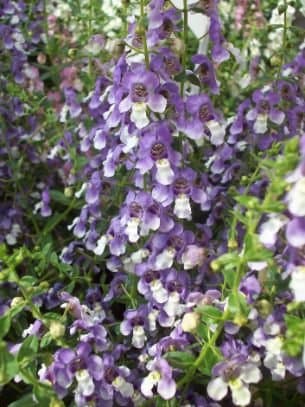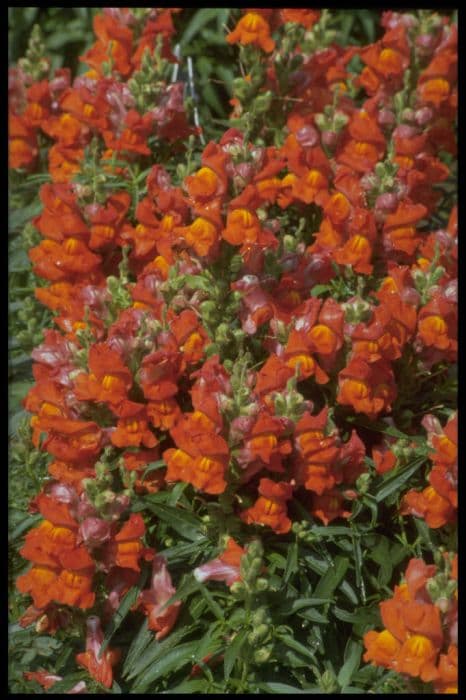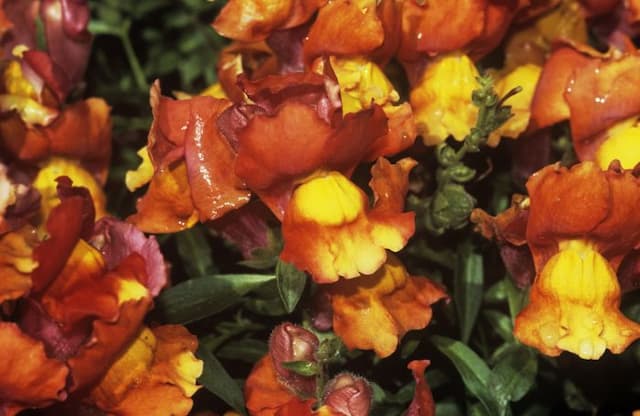Cascade Penstemon Penstemon serrulatus

ABOUT
Penstemon serrulatus, commonly known as Cascade Penstemon, showcases a splendid floral display that is a favorite of both gardeners and pollinators. Its foliage is predominantly lance-shaped and can present a glossy appearance, with edges that are sometimes finely toothed. The stems are upright and bear the weight of the bloom spikes gracefully. This plant really shines when it comes to its blooms. The Cascade Penstemon's flowers are tube-shaped, a perfect design for visiting hummingbirds that often seek out their nectar. These blossoms can be found in varying shades of blue to violet, providing a cool-toned spectrum of color that is both soothing and striking in a natural setting. The flowers are densely packed into panicles, creating a lush look during the blooming season. The overall impression of the Cascade Penstemon is one of a plant that is as hardy as it is beautiful, capable of adding long-lasting visual interest and ecological value to a landscape.
About this plant
 Names
NamesSynonyms
Cascade Penstemon, Sawtooth Penstemon, Coast Penstemon.
Common names
Penstemon serrulatus.
 Toxicity
ToxicityTo humans
The plant known as Cascade penstemon (Penstemon serrulatus) is not generally recognized as toxic to humans. There are no well-documented cases or significant concerns regarding toxicity for this specific species if ingested. Cascade penstemon is largely considered safe and does not typically pose a threat when touched or ingested in small quantities. However, as with any plant material, individual allergic reactions are possible, and it is generally advisable to avoid ingesting any plant parts unless they are known to be edible.
To pets
Similar to its effects on humans, Cascade penstemon (Penstemon serrulatus) is not commonly known to be toxic to pets such as dogs and cats. This plant is not listed among the common toxic plants that pose risks to domestic animals. Pets that ingest Cascade penstemon may not show any symptoms of poisoning, as it is not recognized for having toxic properties. However, ingestion of any non-food plant material can potentially cause mild stomach upset in pets, so it is wise to monitor your pet and consult a veterinarian if you observe any signs of distress or unusual behavior after consumption.
 Characteristics
CharacteristicsLife cycle
Perennials
Foliage type
Deciduous
Color of leaves
Green
Flower color
Blue
Height
2 feet (60 cm)
Spread
2 feet (60 cm)
Plant type
Herb
Hardiness zones
4
Native area
North America
Benefits
 General Benefits
General Benefits- Attracts Pollinators: Penstemon serrulatus, commonly known as Cascade Penstemon, is beneficial for attracting bees, butterflies, and other pollinators to the garden, thus promoting biodiversity.
- Aesthetic Appeal: Cascade Penstemon adds visual interest to landscaping with its spikes of blue to purple flowers, providing a splash of color from late spring to early summer.
- Drought Tolerance: Once established, Cascade Penstemon is relatively drought-tolerant, making it suitable for xeriscaping or low-water-use gardens.
- Cold Hardy: It is known for being cold hardy and can thrive in USDA zones 4-8, expanding its usefulness to gardeners in cooler climates.
- Low Maintenance: Cascade Penstemon does not require extensive care, making it a good choice for gardeners seeking low-maintenance plants.
- Native Plant Advantage: As a native North American species, it often performs better and is more resilient in its local environment compared to non-native species.
- Habitat Support: Its flowers and seeds can provide a food source for local wildlife, including birds and small mammals.
- Erosion Control: The root systems of perennials like Cascade Penstemon can help stabilize soil and control erosion on slopes and banks.
 Medical Properties
Medical PropertiesThis plant is not used for medical purposes.
 Air-purifying Qualities
Air-purifying QualitiesThis plant is not specifically known for air purifying qualities.
 Other Uses
Other Uses- Coastal penstemon flowers are a nectar source for pollinators like hummingbirds and bees, playing a crucial role in the ecosystem by supporting the food chain.
- In landscape design, the coastal penstemon is used for its aesthetic appeal, adding bursts of color with its pink to lavender-tinted flowers.
- This plant is utilized in erosion control efforts due to its ability to thrive in challenging conditions and stabilize soils with its root system.
- Coastal penstemon can be a valuable addition to butterfly gardens, attracting and providing resources for various butterfly species.
- Its resistance to deer browsing makes coastal penstemon a practical choice for gardens in areas with high deer populations, reducing the need for protective measures.
- This species can be part of a fire-resistant landscaping plan to create defensible space around structures in fire-prone areas.
- Native American cultures have traditionally used the coastal penstemon in ceremonial practices due to its prominence and beauty.
- The seed capsules of the coastal penstemon have been used in crafting, for example in the creation of natural jewelry or as decorative elements in art projects.
- As a drought-tolerant plant, coastal penstemon serves as an example specimen in educational settings to teach about water-wise gardening and conservation.
- The plant’s structure and growth patterns make it a subject for botanical study and plant physiology research, particularly in the context of adaptation to mountainous environments.
Interesting Facts
 Feng Shui
Feng ShuiThe Cascade penstemon is not used in Feng Shui practice.
 Zodiac Sign Compitability
Zodiac Sign CompitabilityThe Cascade penstemon is not used in astrology practice.
 Plant Symbolism
Plant Symbolism- Attraction and Charm: Often found in gardens, the vibrant Penstemon, or Beardtongue, is commonly perceived as a symbol of allure and magnetism due to its colorful and inviting blossoms.
- Diversity and Adaptability: As there are many varieties of Beardtongue, they symbolize versatility and the ability to thrive in various conditions, reflecting resilience and adaptability in life.
- Balance in Life: The way Penstemon grows, with its structured form and upright stature, can represent the need for balance and order in one's existence.
- Health and Well-being: Traditional uses of the Penstemon plant in herbal remedies can make it emblematic of healing and good health.
- Open Communication: The open, mouth-like appearance of the Beardtongue flowers is often said to symbolize open dialogue and honesty in interactions.
 Water
WaterThe Cascade Penstemon should be watered deeply to encourage deep root growth, roughly one inch of water per week during the growing season. It's important to allow the soil to dry out slightly between watering to prevent root rot. In the absence of rain, water the plant once a week with approximately 0.625 gallons per square yard of soil area. Adjust watering frequency based on weather conditions; during prolonged dry spells, you may need to water more frequently, while in cooler or rainy periods, less watering is required. In the winter, when the plant is dormant, reduce watering significantly, providing only enough to keep the roots from drying out completely.
 Light
LightThe Cascade Penstemon prefers full sun to partial shade and will thrive with at least six hours of direct sunlight each day. The best spot for this plant is in an area that receives morning sunlight and is partially protected from the intense heat of the afternoon sun, although it is quite adaptable to different light conditions as long as it gets adequate sunshine.
 Temperature
TemperatureCascade Penstemon can survive in a range of temperatures and is hardy in temperatures as low as 10°F. The ideal temperature for active growth is between 60°F and 75°F. It is important not to expose the plant to prolonged temperatures above 90°F, where it may require additional shade or water to prevent stress.
 Pruning
PruningPruning Cascade Penstemon promotes a bushier growth habit and encourages more blooms. The best time for pruning is in early spring, just before new growth starts. Cut back the previous year's growth by about one third to stimulate the plant. Deadheading, or removing spent flowers, will also encourage a second bloom in late summer or early fall. Pruning after the last blooms fade in autumn can help prepare the plant for winter by removing any diseased or damaged tissue.
 Cleaning
CleaningAs needed
 Soil
SoilThe Cascade Penstemon prefers well-draining soil with a pH ranging from slightly acidic to neutral (6.0-7.0). A suitable soil mix can be created with equal parts loam, sand, and peat moss to ensure proper drainage and aeration. Regular organic matter addition helps maintain soil fertility.
 Repotting
RepottingCascade Penstemon does not require frequent repotting and should be transplanted every 2-3 years or when it outgrows its current container. Repotting is best done in the spring.
 Humidity & Misting
Humidity & MistingCascade Penstemon thrives in moderate humidity conditions but is quite adaptable and can tolerate lower humidity levels typical of most household environments.
 Suitable locations
Suitable locationsIndoor
Place in bright indirect light and ensure good air circulation.
Outdoor
Plant in full sun to part shade in well-draining soil.
Hardiness zone
4-8 USDA
 Life cycle
Life cyclePenstemon serrulatus, commonly known as Cascade Penstemon, begins its life cycle when the seeds germinate in the spring, provided there's sufficient moisture. The seedlings then develop into a rosette of leaves close to the ground. As the plant matures, typically in its second year, it develops tall flowering stems that bear tubular flowers, usually ranging from blue to violet, which are attractive to pollinators such as bees and hummingbirds. After pollination, the flowers produce seed capsules that eventually release seeds, continuing the cycle. In the fall, the above-ground part of the plant may die back, with the plant surviving the winter as a perennial root system. In subsequent years, the Cascade Penstemon will continue this cycle, growing anew from its overwintering roots to flower and set seed each year.
 Propogation
PropogationPropogation time
Spring to Summer
The most popular method of propagating Penstemon serrulatus, commonly known as Cascade penstemon, is through seed propagation. This process typically begins in the fall, aligning with the plant's natural seed dispersal period. To propagate Cascade penstemon by seed, one should collect the seeds when the flower heads are dry and the seeds are mature. Then, sow the seeds directly into a well-draining soil medium, barely covering them, as they require light to germinate. It is important to keep the soil consistently moist but not waterlogged. Under appropriate conditions, which usually involve cool temperatures between 60 to 70 degrees Fahrenheit (15.6 to 21.1 degrees Celsius), germination will occur in two to three weeks. Sowing seeds in the fall allows for a natural stratification period throughout the winter, breaking seed dormancy and promoting spring germination.









